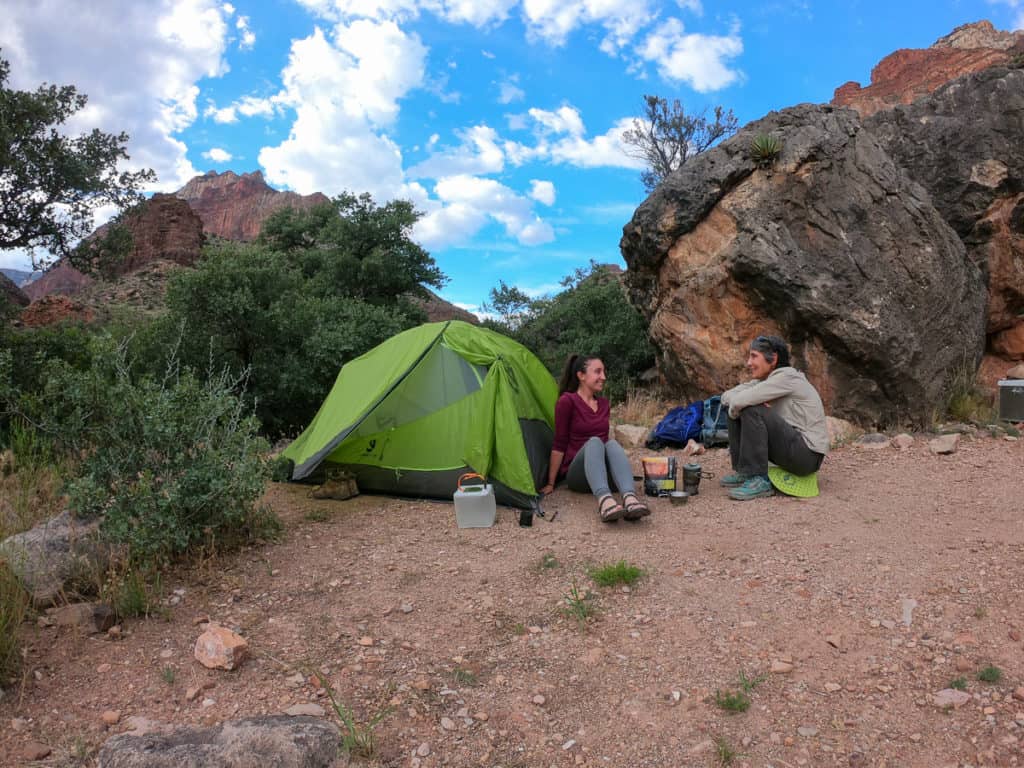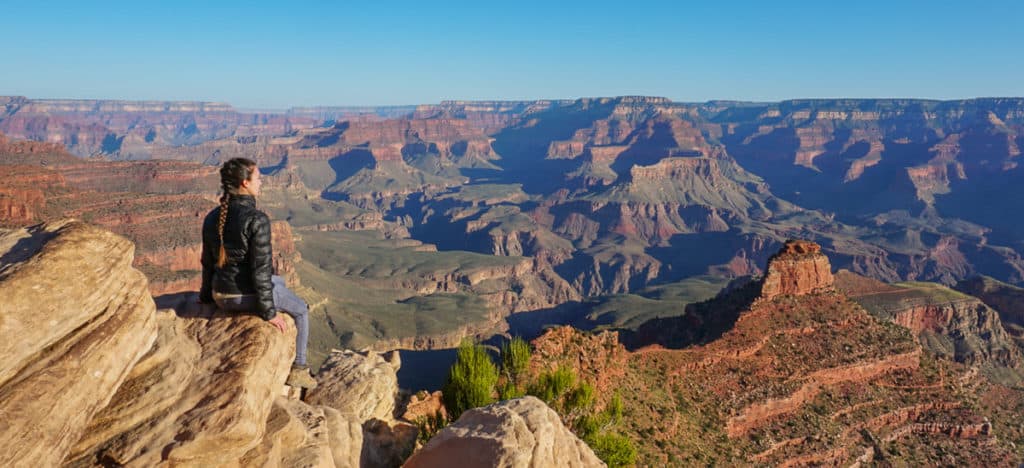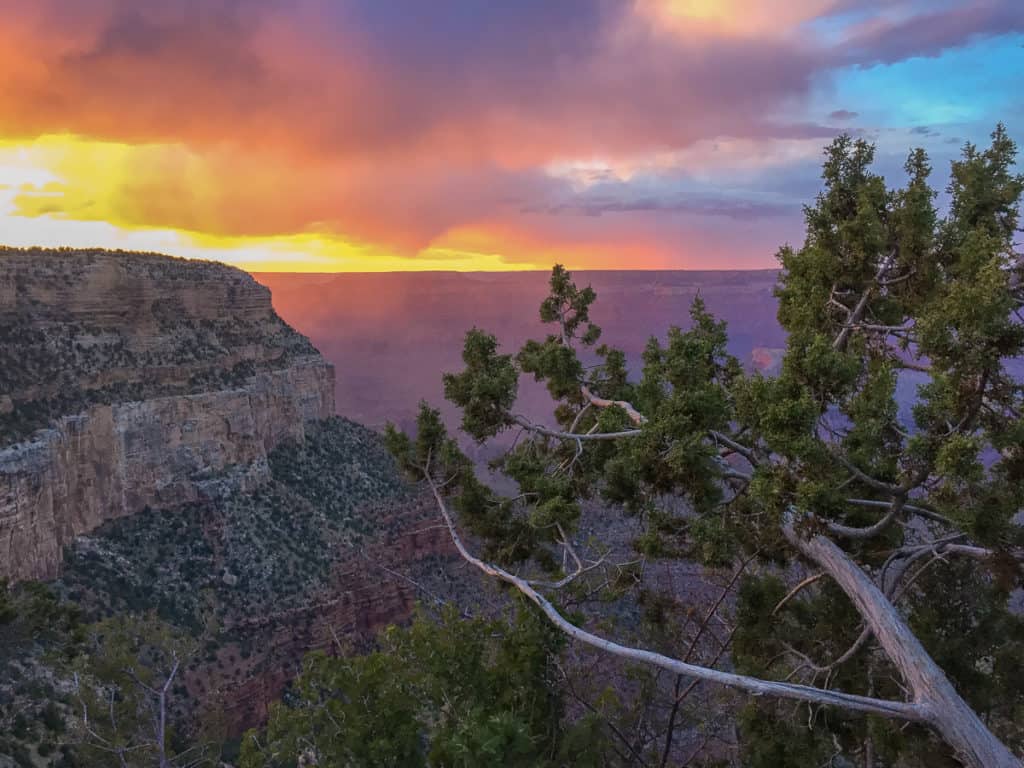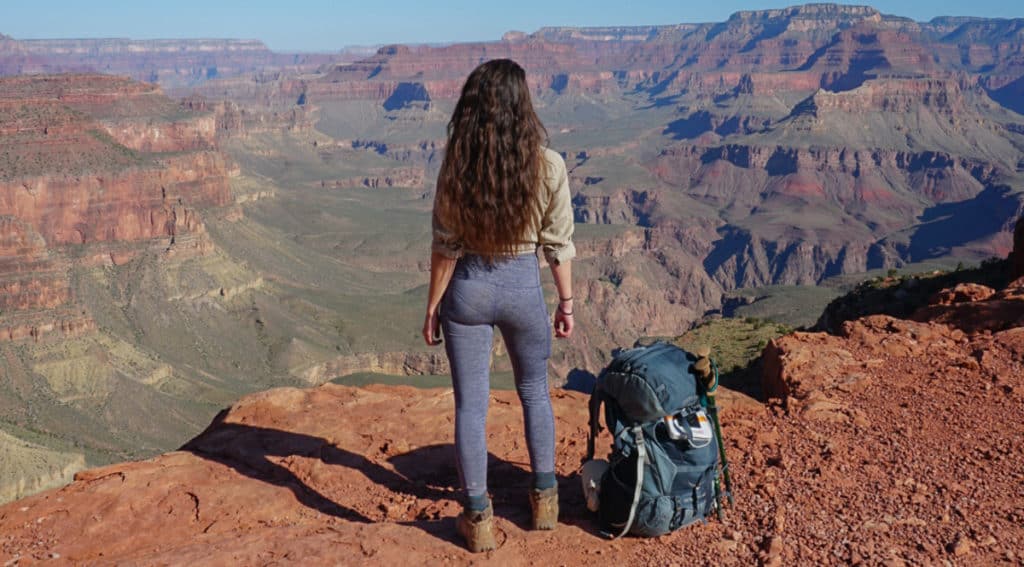Hiking the Grand Canyon from rim to rim is a once in a lifetime experience that easily made it into my top 3 favorite hikes of all time. The day’s last rays of light reflecting off the multicolored rocks, the steady babble of Bright Angel Creek, the curious wildlife, and the desert landscape slowly morphing into Pine and Aspen trees make for an unforgettable backcountry hike.
I hiked the canyon in the first week of June with my mom who was thru-hiking the 800-mile Arizona Trail. Meaning, she had already hiked 700+ miles from the Arizona/Mexico border to get to the Grand Canyon South Rim, and was in much better shape than I was.
After 3 days and 21 miles down and then up, and sometimes down again, the Grand Canyon Rim to Rim hike bumped into first place for the most consistently beautiful hike I’ve ever done (and I’ve done some noteworthy hikes in the Andes, New Zealand, Canadian Rockies, and even Havasupai). EVERY. SINGLE. STEP. from South Kaibab trailhead to North Kaibab Trailhead was indescribably beautiful in its own right. Seriously, the entire hike is stunning!
So if you want to see tons of pictures, know when to go, where to park overnight, what kind of permit you need, how much it costs, where to camp, what to do with pets, what trail to take, what to pack, how hard the hike is and what makes it so special…then keep scrolling down.
There are many ways to experience the beauty of the Grand Canyon, both in and outside of the National Park, but a rim to rim hike is an epic way to take in this natural wonder by foot. Not to mention, it is less crowded than hiking to Havasupai and much more accessible than getting a spot on a long wait list for rafting down the Colorado River.

The Canyon itself is 277 miles long, up to 18 miles wide, and reaches depths of a mile! The steep-sided cliffs and contours were carved by the Colorado River over the span of 5 million years, creating the iconic views you see today.
The Grand Canyon is home to the Havasupai tribe, the smallest and most remote Native American Nation in the country, and the only place in America where mail is still delivered by mule. The Canyon is also home to more than 1,500 plant, 355 bird, 89 mammalian, 47 reptile, 9 amphibian and 17 fish species, according to the National Park Service.
90% of visitors experience it from the viewpoints at the South Rim, and way fewer see it from the 1000 foot taller North Rim.
The beauty of hiking rim to rim, whichever way you choose to do it, is that you get to see the Grand Canyon from multiple perspectives.
When to Hike

The North Rim is only open from mid-May to mid-October, so unless you are an advanced hiker and want to do a rim-to-rim-to-rim hike which is a minimum of 42 miles and would need to begin and end at the South Rim, then you can only do a rim to rim hike from May 15th to October 15th.
Theoretically, a trip in late May or September would provide the least weather obstacles.
Summer
REALLY HOT (but it’s a dry heat), with regular thunderstorms in July and August. Temperatures throughout the summer soar to 120°F!
Average temperature at the South Rim: 48°F to 83°F
Average temperature at the bottom (near the Colorado River, and Bright Angel Campground): 74°F to 104°F
**The thermometer in the sun at Bright Angel Campground read 125°F when I was hiking in the first week of June, and two people had to be evacuated by helicopter for heat exhaustion**
It is highly recommended not to hike between 10 am and 4 pm to avoid the extreme heat.
Spring and Fall
The weather is fickle but mostly cool (it can snow or be extremely hot and high winds are common).
Average temperature at the South Rim: 32°F to 63°F
Average temperature at the bottom (near the Colorado River, and Bright Angel Campground): 56°F to 82°F
Page 3 of this Grand Canyon Hiking Brochure explains extensively what to expect weather wise in each season in the canyon.
What to Pack

- WATER
- bring at least a liter on your way down, and 2 on your way up
- water filter or treatment method (I highly recommend this 1L fast filter collapsible lightweight bottle)
- Food
- salty snacks (e.g. Kind bars, Larabars, Cliff Bars, and trail mix)
- high-calorie meals (Backpacker’s Pantry & Good-to-Go are my favorites and they have lots of vegetarian and gluten-free options)
- electrolytes (tablets are simplest to carry)
- energy hydration/nutrition gel (GU is my favorite)
- First Aid Kit (with blister care, duct tape is extremely useful, and a small pocket knife)
- Map (you can get a free one at the visitor or backcountry information centers and/or print out page 6 of this hiking brochure)
- Headlamp and/or solar lantern (LuminAid’s Packlite Max 2-in-1 solar phone charger was ranked #1 backpacking lantern by REI)
- Get 15% off a LuminAid Lantern with code: SPINTHEGLOBE
- Sun Protection (sunscreen, hat, and sunglasses)
- Hiking shoes/boots (make sure they are broken in before your trip)
- Layers of quick dry clothing with sun protection
- lightweight rain jacket (depending on the season)
- lightweight down jacket (can double as a pillow)
- Backpacking tent (this is the one my mom and I used for this trip)
- Backpacking backpack (this is mine)
For a more comprehensive list of backpacking clothes and gear, check out my backpacking essentials guide & checklist.
The Cost

Grand Canyon National Park entrance fee:
- $35 per vehicle or $30 for a motorcycle for a 7-day pass
I highly recommend the $80 America the Beautiful National Parks and Federal Recreational Lands Annual Pass (it’s definitely worth it if you plan to visit 3 or more parks within a year).
Backcountry camping permits:
- $10 per permit (plus $8 per person/night) camped below the rim
- $8 per group per night camped above the rim
Other Optional Services
Trans-Canyon Shuttle– rim to rim ride service so you can leave your car at one end of the canyon (more info below):
- $90/one way/person
Phantom Ranch (A lottery based cabin style accommodation near Bright Angel Campground at the bottom of the Grand Canyon):
- $155 for a cabin for 2 people/night
- $53 for dorm bunk bed/night
Duffel Service (A mule carries your bag down to or up from Phantom Ranch from the South Rim):
- $70 each way
- Maximum dimensions per duffel are 36” x 20” x 13” (up to 30 pounds)
- Book at the counter inside any of the Grand Canyon Lodges
- Bag drop off is by 3:30pm the day before at the Xanterra Livery Barn

For more information on Phantom Ranch accommodations, meals, and duffel services: go here.
Pet Kennel (overnight boarding options for dogs and cats):
- $26.50 Overnight dog (50 pounds or less)
- $30 Overnight dog (50 pounds or more)
- $17.50 Overnight cat
For more information on kennel services, call 928-638-2631 or 928-638-0534 or visit the park services page.
Getting A Backcountry Camping Permit

There are two ways to get the necessary backcountry camping permit for any of the three campgrounds in the canyon (Indian Garden, Bright Angel, and Cottonwood).
- Submit a Permit Request Form by fax, mail or in person. Forms should be received by 5pm on the 1st day of the month, 4 months prior to your trip start date for the best chance of getting your selected itinerary (Note: Processing can take up to 3 weeks).
- Fax request to the Backcountry Information Center: 928-638-2125
- Mail request to Grand Canyon Permits Office:
- 1824 S Thompson Street, #201, Flagstaff AZ, 86001
- Bring request to the Backcountry Information Center (located inside the park on both the South and the North Rim)
2. Get a last-minute walk-up permit at either the South or North Rim Backcountry Information Centers (This option is for people with some flexibility or Arizona Trail thru-hikers. You may have to spend a few days on the rim until you get your ideal itinerary).
Backcountry Information Center:
- Open daily: 8 am to noon and 1-5 pm
- North Rim Office is only open mid-May to mid-October and located in the admin building
A limited number of last-minute permits are available and they are only good for one or two consecutive nights, and cannot be purchased more than one day prior to the start of a hike.
**Note: last-minute permit priority for Bright Angel and Indian Garden campgrounds are given to people on the South Rim, and Cottonwood Campground permit priority is given to those on the North Rim.**
My mom and I were able to bypass this last-minute priority system and camp in the “stock camp” for mules and horses, because she was an Arizona Trail thru-hiker and we were sharing a tent.
You can find more backcountry permit information here.
The Trails

There are 3 main trails inside the Grand Canyon: North Kaibab, South Kaibab, and Bright Angel. Each has multiple rest/viewpoints, varying elevation changes and difficulty as can be seen in the picture above.
The three trails make up four routes you can choose for a rim to rim hike (1 & 2 begin from the South Rim, 3 & 4 begin from the North Rim):
- South Kaibab Trail to North Kaibab Trailhead
- Bright Angel Trail to North Kaibab Trailhead (easier)
- North Kaibab Trail to South Kaibab Trailhead
- North Kaibab Trail to Bright Angel Trailhead (easier)

I did number 1 above and completed it in 3 days and 2 nights, breaking it into manageable 7-mile/day chunks, which I highly recommend!
I started at the South Kaibab Trailhead, camped in Bright Angel Campground, then hiked to Cottonwood campground on day 2, and out the Canyon on the North Kaibab Trail the third day. This route ended up being 20.7 miles in total, and even as an experienced hiker (albeit not currently in shape) this route was strenuous and made me sore.
Trail Distance/Elevation Change from trailheads to campgrounds (from the South Rim):
Bright Angel Trailhead (6840ft/ 2085m) to Indian Garden Campground:
- 4.5 miles
- 3,400 ft elevation change
Bright Angel Trailhead (6840ft/ 2085m) to Bright Angel Campground:
- 9.5 miles
- 4,340 ft elevation decrease
- Some shade and seasonal water available
- All the park rangers said this is the easier trail to go down
South Kaibab Trailhead (7200ft/ 2195m) to Bright Angel Campground:

- 7 miles
- 4,700 ft elevation decrease (very steep)
- NO SHADE & NO WATER
- Exposed ridgeline the entire way
Trail Distance/Elevation Change from Trailheads to Campgrounds (from the North Rim):
North Kaibab Trailhead (8240ft/2511m) to Cottonwood Campground:
- 6.5 miles
- 4,200 ft elevation change
- Some shade on the trail, seasonal water
North Kaibab Trailhead (8240ft/2511m) to Bright Angel Campground:
- 13.7 miles
- 5,740 ft elevation change
- Some shade, seasonal water

You should choose a route based on your abilities. Pages 4-6 in this Grand Canyon Hiking Brochure are very helpful for planning the hike that is the best match for your physical fitness level.
No matter which trail, route, or campgrounds you choose for your trip, it is highly recommended that you set aside 3-4 days to do a rim to rim hike!
I also recommend that you start from the North and hike South, to decrease the amount of ground you have to cover going uphill because the North Rim is over 1000 feet taller! If I did it again, I would follow one of the first two itineraries below.
Recommended Itineraries

North to South Rim
4 days/3 nights (for beginner or moderate hikers):
- Day 1: Start at North Kaibab Trailhead and camp at Cottonwood campground (6.5 miles)
- Day 2: Hike from Cottonwood to Bright Angel Campground (7.2 miles)
- Day 3: Hike from Bright Angel Campground to Indian Garden Campground (5 miles)
- Day 4: Hike from Indian Garden to Bright Angel Trailhead (4.5 miles)
3 days/2 nights (for experienced hikers):

- Day 1: Start at North Kaibab Trailhead and camp at Cottonwood Campground (6.5 miles)
- Day 2: Hike from Cottonwood to Bright Angel campground (7.2 miles)
- Day 3: Hike from Bright Angel Campground to South Kaibab Trailhead (7 miles)
2 days/1 night (ONLY IF YOU ARE AN ADVANCED HIKER):

- Day 1: Start from North Kaibab Trailhead and camp at Bright Angel Campground (13.7 miles)
- Day 2: Hike from Bright Angel Campground up South Kaibab Trail (7 miles)
South to North Rim
4 days/3 nights (for beginner hikers):
- Day 1: Start at Bright Angel Trailhead and hike to Indian Garden (4.5 miles)
- Day 2: Hike from Indian Garden to Bright Angel Campground (5 miles)
- Day 3: Hike from Bright Angel to Cottonwood Campground (7.2 miles)
- Day 4: Hike from Cottonwood to North Kaibab Trailhead (6.5 miles)
3 days/2 nights (for beginner to moderate hikers):

- Day 1: Start at Bright Angel Trailhead and camp at Bright Angel Campground (9.5 miles)
- Day 2: Hike from Bright Angel to Cottonwood campground (7.2 miles)
- Day 3: Hike from Cottonwood to North Kaibab Trailhead (6.5 miles)
3 days/2 nights (for moderate to advanced hikers):

- Day 1: Start at South Kaibab Trailhead and hike to Bright Angel Campground (7 miles)
- Day 2: Hike from Bright Angel to Cottonwood Campground (7.2 miles)
- Day 3: Hike from Cottonwood to North Kaibab Trailhead (6.5 miles)
Getting Around and Parking
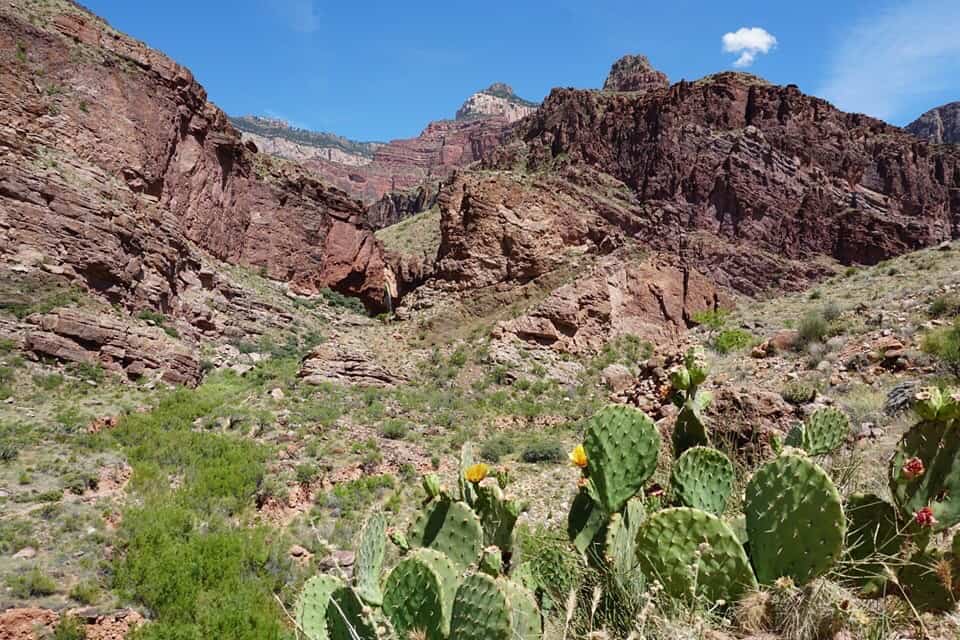
South Rim
Overnight Parking: You can park overnight for free in the Backcountry Information Center (Parking Lot D). It is recommended that you share your license plate number with the ranger when you purchase your permit.
Hiker’s Shuttle: There is a free hiker’s express morning shuttle bus with four stops: Bright Angel Lodge (where you want to get off if you are hiking from Bright Angel Trailhead), Backcountry Information Center (where you can leave your car during your trip), Grand Canyon Visitor Center, and South Kaibab Trailhead.
Times that shuttle leaves Bright Angel Lodge (takes about 30 minutes from Lodge to South Kaibab):
- May/September: 5am, 6am, 7am
- June/July/August: 4am, 5am, 6am
North Rim

Overnight Parking: You can park for free at the North Kaibab Trailhead (It is 1.7 miles from the Grand Canyon Lodge)
Grand Canyon Lodge Hiker Shuttle (May 15- October 15):
A shuttle to the North Kaibab Trailhead picks up passengers in front of the Grand Canyon Lodge at 5:45 am and 7:10 am. Make reservations 24 hours in advance at the lodge front desk.
Other services are listed in the North Rim Pocket Map.
Trans-Canyon Shuttle
You can purchase a rim to rim shuttle beforehand so you can leave your car at one end of the canyon.
- $90/one way/person
- 7 am and 2 pm pick up times from North or South Rim
- 4.5-hour drive
- Reservations are required at least 48 hrs in advance. Call (928) 638-2820 or Book Online
Visit their website for more information.
What to Expect When Hiking the Grand Canyon

The trail is absolutely beautiful from every side, angle, and time of day. The landscape varies between high desert and forest vegetation. So you’ll definitely want to keep your camera out the whole time because there are uniquely dramatic and stunning views around every corner!

The most common wildlife sightings are in the form of deer, squirrels, frogs, and lizards (based on my personal experience).

There are bathrooms with composting toilets along the trail and at campgrounds (some have hand sanitizer and toilet paper and others don’t, so I recommend bringing your own).

If you have a water filtration system, there are multiple Bright Angel Creek access points (just off the trail) where you can refill your water container from Bright Angel Campground all the way to Manzanita Rest Area.
The trail is crowded with day hikers especially the first few miles from each trailhead on the North and South Rim, but thins out further down and closer to the campgrounds.

You CANNOT swim in the Colorado River due to strong currents and extreme temperatures. You can, however, swim in Bright Angel Creek at your own risk.

The squirrels are insanely sneaky and will chew holes in your tent, backpack and clothes if you leave anything with a scent out. For that reason, each campground has clear instructions on how to safely store your food, lotion etc., and provides metal boxes for your gear.
Don’t forget to check in with a ranger before you begin hiking to verify up to date trail information, water sources, and weather forecasts. Hiking the Grand Canyon is not a casual hike, there are only 2 ways out if something goes wrong: by foot, or by helicopter. So unless you want to rack up a hefty medical bill, please hike with care.
Come physically prepared, pack light, bring plenty of water and sun protection, hike early, and rest if you are tired.
Most importantly, enjoy the grandness of the canyon, keep an eye open for critters, soak in the dramatic panoramic views, and take time to show the canyon the respect it deserves!

Also, if you’re flying in from out of town or from another country, you might find the logistical tips below helpful.
| Logistical Tips for Booking Your Trip |
| Booking Flights I typically use Skyscanner to book my flights because it allows you to search through websites and airlines worldwide all in one convenient search engine. You can also get price alerts for flights you’re interested in. |
| Booking Accommodation I always book my hostels through Hostelworld. If I’m not staying in a hostel, then I often book an |
| Using a VPN for Online Bookings I also use a VPN (a powerful virtual tool that provides you with a private, anonymous, and secure internet connection) when searching for flights, accommodation, and rental cars. Since websites track your online activity and location, then use these factors to make the rates you are given dramatically higher than their true value, a VPN ensures that you get the best rates, by eliminating artificially high prices based on your country and internet search history. I recommend an affordable VPN like Surfshark to make sure you are getting the best travel deals online! |
| Travel Insurance I always travel with insurance, because I know all too well how many things can go wrong while traveling (and sometimes even beforehand). Travel insurance can protect you against certain cancellations, theft, lost luggage, trip interruptions, medical emergencies, and more. I use and highly recommend InsureMyTrip to find, compare and buy the plan that makes the most sense for each trip. |
| Other Travel Resources Check out my Travel Resources Page to see the best companies, apps, jobs and other resources I use when traveling on a tight budget. |


